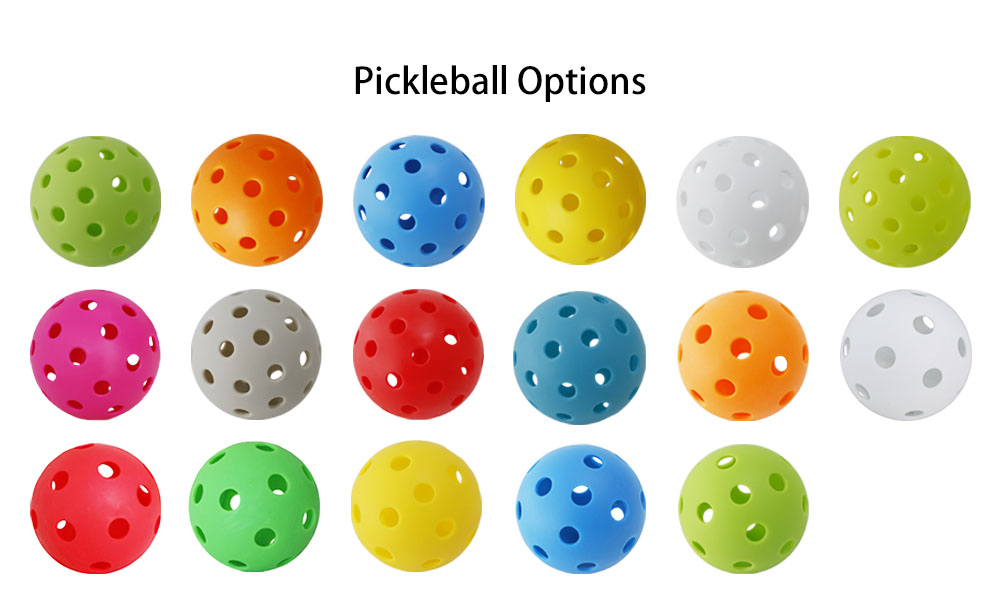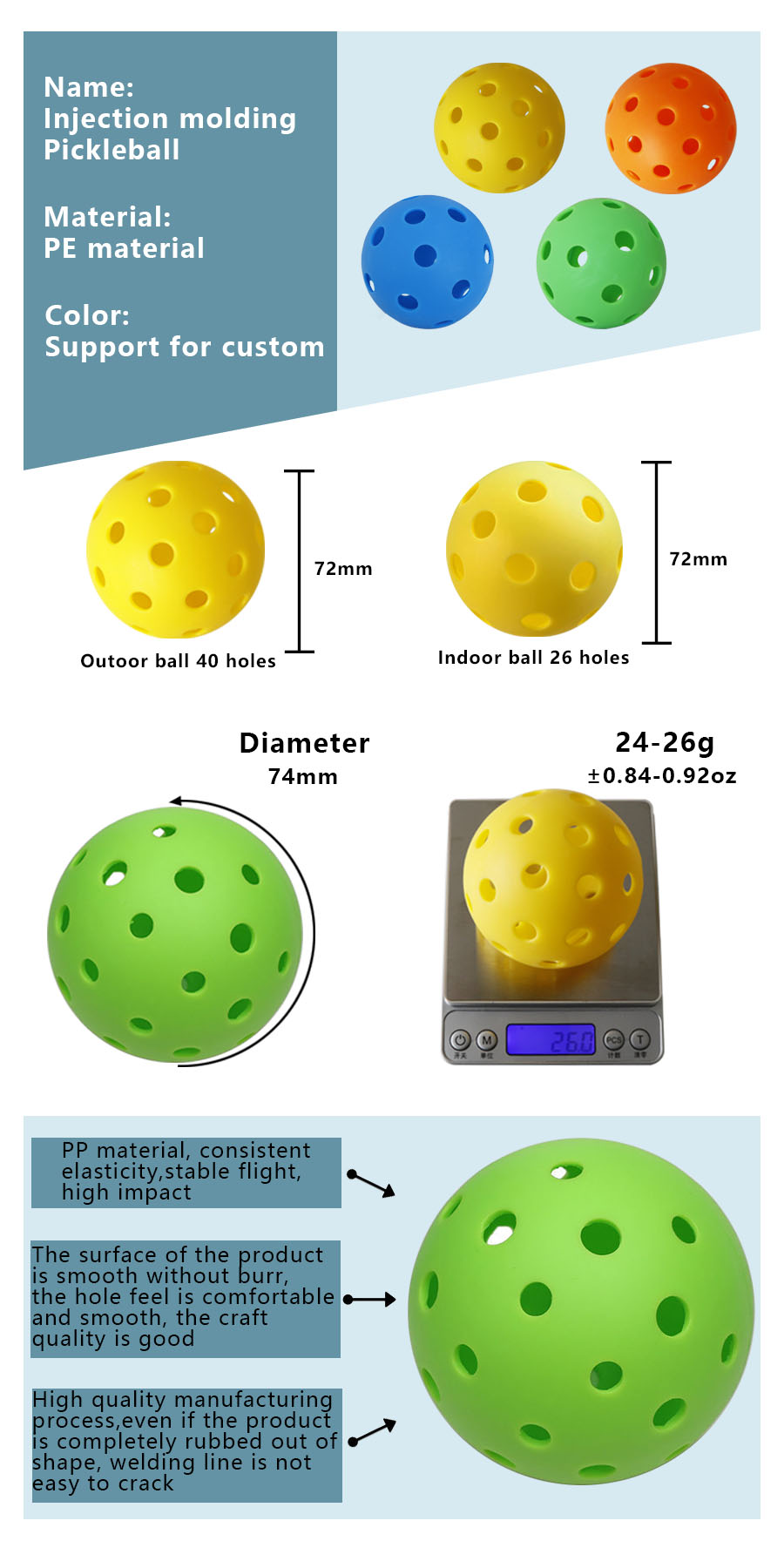- English
- Español
- Português
- русский
- Français
- 日本語
- Deutsch
- tiếng Việt
- Italiano
- Nederlands
- ภาษาไทย
- Polski
- 한국어
- Svenska
- magyar
- Malay
- বাংলা ভাষার
- Dansk
- Suomi
- हिन्दी
- Pilipino
- Türkçe
- Gaeilge
- العربية
- Indonesia
- Norsk
- تمل
- český
- ελληνικά
- український
- Javanese
- فارسی
- தமிழ்
- తెలుగు
- नेपाली
- Burmese
- български
- ລາວ
- Latine
- Қазақша
- Euskal
- Azərbaycan
- Slovenský jazyk
- Македонски
- Lietuvos
- Eesti Keel
- Română
- Slovenski
- मराठी
- Srpski језик
Are there different types of pickleball balls and how do they affect the game?
2023-03-22
Pickleball is a popular racquet sport that requires the use of a ball with holes. Different types of pickleball balls are available in the market, each designed to cater to different playing conditions and skill levels. In this article, we will discuss the various kinds of pickleball balls, their differences, and how they impact the game.
Indoor pickleball balls are specifically designed for indoor courts. These balls are lightweight and have larger holes than outdoor balls, making them slower and easier to control. The lower bounce of indoor balls also requires players to use more finesse when hitting the ball. This design encourages longer rallies and strategic gameplay. Additionally, indoor balls tend to be quieter and less bouncy, which makes them suitable for indoor play.
Outdoor Balls
Outdoor pickleball balls are intended for playing on outdoor courts. They are heavier than indoor balls and have smaller holes, which makes them more aerodynamic and better able to withstand wind and humidity. Outdoor balls have a higher bounce, allowing players to hit the ball with more power and speed. The increased bounce creates faster rallies and encourages more aggressive play, requiring players to use more power and strength during their shots.
Pickleball balls can be manufactured using different methods, including injection molding and rotational molding. The main difference between these two techniques lies in the way the ball is formed and the resulting characteristics of the ball.
Injection Molding
Injection molding is a process where raw materials are melted and injected into a mold under high pressure to form a specific shape. In the case of pickleball balls, plastic pellets are melted and injected into a mold that creates the ball's shape. Injection molding produces balls with a smooth surface and consistent wall thickness, which provides better control and accuracy during play. The balls are also more durable and have a longer lifespan since the material is evenly distributed throughout the ball.
Rotational Molding
Rotational molding is a process where a hollow mold is filled with the raw material and rotated on two axes while being heated. The heat melts the material, and it coats the mold's interior to form the desired shape. Rotational molding produces pickleball balls with a thicker wall and rougher surface texture, which can affect the ball's flight path and bounce. The balls are also less durable than injection molded balls, as the material is not evenly distributed throughout the ball.
In summary, injection molding produces smoother, more consistent pickleball balls with better control and accuracy, while rotational molding produces balls with a rougher surface texture and a thicker wall, affecting the ball's flight path and bounce. Injection molded balls are also more durable due to the even distribution of the material throughout the ball. However, the manufacturing cost of injection molding is generally higher than rotational molding. Ultimately, the choice of manufacturing method depends on the desired properties and budget for the pickleball balls.

Indoor pickleball balls are specifically designed for indoor courts. These balls are lightweight and have larger holes than outdoor balls, making them slower and easier to control. The lower bounce of indoor balls also requires players to use more finesse when hitting the ball. This design encourages longer rallies and strategic gameplay. Additionally, indoor balls tend to be quieter and less bouncy, which makes them suitable for indoor play.
Outdoor Balls
Outdoor pickleball balls are intended for playing on outdoor courts. They are heavier than indoor balls and have smaller holes, which makes them more aerodynamic and better able to withstand wind and humidity. Outdoor balls have a higher bounce, allowing players to hit the ball with more power and speed. The increased bounce creates faster rallies and encourages more aggressive play, requiring players to use more power and strength during their shots.
Pickleball balls can be manufactured using different methods, including injection molding and rotational molding. The main difference between these two techniques lies in the way the ball is formed and the resulting characteristics of the ball.
Injection Molding
Injection molding is a process where raw materials are melted and injected into a mold under high pressure to form a specific shape. In the case of pickleball balls, plastic pellets are melted and injected into a mold that creates the ball's shape. Injection molding produces balls with a smooth surface and consistent wall thickness, which provides better control and accuracy during play. The balls are also more durable and have a longer lifespan since the material is evenly distributed throughout the ball.
Rotational Molding
Rotational molding is a process where a hollow mold is filled with the raw material and rotated on two axes while being heated. The heat melts the material, and it coats the mold's interior to form the desired shape. Rotational molding produces pickleball balls with a thicker wall and rougher surface texture, which can affect the ball's flight path and bounce. The balls are also less durable than injection molded balls, as the material is not evenly distributed throughout the ball.
In summary, injection molding produces smoother, more consistent pickleball balls with better control and accuracy, while rotational molding produces balls with a rougher surface texture and a thicker wall, affecting the ball's flight path and bounce. Injection molded balls are also more durable due to the even distribution of the material throughout the ball. However, the manufacturing cost of injection molding is generally higher than rotational molding. Ultimately, the choice of manufacturing method depends on the desired properties and budget for the pickleball balls.






